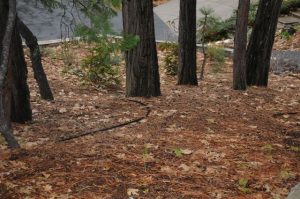Mulches, the soil coverings many people associate primarily with weed suppression and garden decoration, also play an important part in plant health and soil structure. The right organic mulch — as opposed to black plastic or decorative rock — can enrich your garden soil.
While the benefits of mulching for soil and plant health are clear, choosing the right mulch for your garden can be confusing because it is a game of tradeoffs. For example, wood chip mulches, which resist compaction and blowing away in the wind, have a high carbon to nitrogen ratio that might temporarily reduce nitrogen in the soil for plant uptake. Cocoa hulls are lovely, but they are expensive and can be toxic to dogs. Straw, great for a summer mulch in vegetable gardens, is highly flammable — not a desirable thing in the Sierra Foothills in August.
That said; here are some tips to help guide your decisions for mulching:
Season – Winter mulches are best for insulating woody plants (trees, bushes, perennials). Late fall, after the soil has cooled but before the first frost, is the perfect time to lay down shredded leaves, pine needles, or straw, which will help keep the soil evenly cool throughout the winter. Summer mulches, best applied in mid-spring when active root growth has started, help retain soil moisture, reduce weeds and keep soil cooler during the hottest months.
Depth – Two to four inches is the suggested depth of garden mulches.
Location – Keep mulch at least six to twelve inches away from tree and shrub trunks, and one inch away from flower/vegetable stems, to avoid rot, cankers and other diseases.
Types – Here are some of the most common mulches used:
Wood chips are readily available and are considered attractive by many gardeners. In the process of decomposing, wood chips can temporarily rob soil of nitrogen, so be sure to replenish the loss with nitrogen fertilizer (or cover crops if you use them), if necessary.
Bark, whether shredded or in chunks, has some of the same advantages of wood chips: it resists compaction, is easy to find, and it is attractive (especially for a more natural look). Commercial bark can, however, be toxic to young plants if it is too fresh or has been stored improperly, according to Cornell University Plantations Director and former Cooperative Extension Agent, Donald Rakow. The best bet is to buy bagged mulch products, which “have been weathered for long periods of time to remove any toxins and are least likely to harm plants.”
Straw or hay is often used in summer vegetable gardens and strawberry patches. It is relatively inexpensive and can also be effective winter insulating mulch. Some disadvantages of straw are that it, too, can lower nitrogen levels in soil, and it might contain grain or weed seeds that can germinate. A thick enough layer can also harbor rodents.
Sawdust, which can have an acidifying effect on soil, can be beneficial to acid-loving plants such as blueberries and rhododendrons. Partly because sawdust is so fine in texture, it compacts very quickly in just one season; so, it is necessary either to fluff it up or replace it each year.
Hulls, obtained from the processing of crops such as buckwheat, cocoa and cottonseed, can add a nice visual texture to a garden bed. However, they are more expensive than traditional mulches, and can more easily be washed away by rains or blown off by strong winds.
Yard “waste,“ such as leaves, pine needles and other non-diseased plant parts, is often the ideal winter or summer mulch, especially if you can chip or shred it into a finer consistency. Pine needles, the bumper crop of free mulch in our area, provide excellent protection year round, but they should be raked up and replaced annually.
Rachel Oppedahl is a University of California Cooperative Extension Master Gardener of Tuolumne County.
Have more questions about mulching? UCCE Master Gardeners of Tuolumne County can answer home gardening questions. Call 209-533-5912 or go to: http://ucanr.edu/survey/survey.cfm?surveynumber=7269 to fill out our easy-to-use problem questionnaire. Check out our website at: http://cecentralsierra.ucanr.edu/Master_Gardeners/ You can also find us on Facebook or pick up the local Master Gardener book “Sharing the Knowledge: Gardening in the Mother Lode” at Mountain Books or the UCCE Office both in Sonora, CA.




